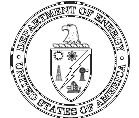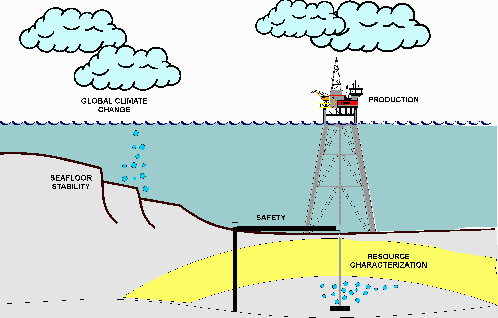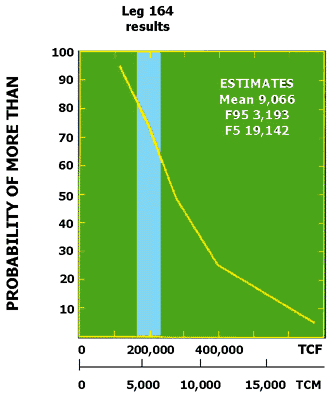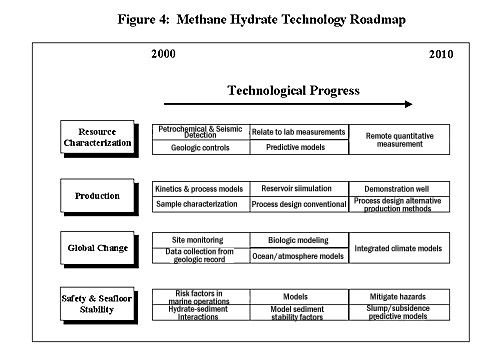U.S. Department of Energy
DRAFT
METHANE HYDRATES
PROGRAM PLAN

U.S. Department of Energy
Office of
Fossil Energy
April 1998
Contents
Executive Summary
1. Introduction
1.1 Methane Hydrates Defined
1.2 Natural Gas Supply and Demand
2. Federal Role
2.1 Why is Fossil Fuel Research Important to the U.S.?
2.2 Why
Should the Federal Government be Involved?
2.3 Stewardship of Public
Resources
2.4 Comprehensive National Energy Strategy
2.5 President's
Council of Advisors on Science and Technology (PCAST)
2.6 Senate Bill
#1418
3. Research History
4. Program Goals and Benefits
4.1 Near-Term
Benefits
4.2 Long-Term Benefits
4.3 Technology Transfer
5. R&D to Answer Technical Issues
5.1
Resource Characterization
5.1.1 Goals
5.1.2 Research
Needs
5.1.3 Program Activities
5.2 Production
5.2.1
Goals
5.2.2 Research Needs
5.2.3 Program
Activities
5.3 Global Change
5.3.1 Goals
5.3.2
Research Needs
5.3.3 Program Activities
5.4 Safety
and Seafloor Stability
5.4.1 Goals
5.4.2 Research
Needs
5.4.3 Program Activities
6. Program Management
6.1 Government Roles and
Responsibilities
6.1.1 DOE
6.1.2 Other Federal
Agencies
6.2 Government Performance and Results Act of 1993
6.3
Peer Review
6.4 Stakeholder Input
6.5 Relationships to Other
Programs
6.5.1 Gas Research Institute (GRI)
6.5.2
Industry
6.5.3 International Cooperation
7. Budget
7.1 Cost Sharing
References
Acronyms and Abbreviations
Appendix 1: State Fact Sheets
Appendix 2: Summary Report of the Workshop on the Future of
Methane Hydrate Research and Resource Development
Appendix 3: Summary of Methane Hydrates Workshop II and
Comments on the Draft Plan
Executive Summary
In the near term, natural gas is expected to take on a greater role in power generation and transportation because of increasing pressure for cleaner fuels and reduced CO2 particulate, sulfur oxides and nitrogen oxides production. Gas demand is expected to also grow throughout the first half of the 21st century because gas may have an expanded transition role as a transportation fuel or a competitive source of transportation liquid fuel (gas-to-liquids conversion) and hydrogen for fuel cells.
Methane production from hydrates can contribute low cost natural gas to satisfy domestic demand. As much as 200,000 trillion cubic feet (Tcf) of methane may exist in hydrate systems in the U.S. permafrost regions and surrounding waters , which is hundreds of times greater than the estimated conventional U.S. gas resource base of 1,400 Tcf. Even if actual reserves prove to be only a small fraction of these estimates, methane hydrate production could alter U.S. and world patterns of energy supply and consumption. Gas production from hydrates will also contribute to energy security and Federal revenues from royalties and lease rentals in the Outer Continental Shelf.
Methane hydrate is a methane bearing, ice-like material that occurs in abundance in marine and arctic sediments and stores immense amounts of methane. A cage of water ice molecules surrounds the gas molecule allowing high methane concentrations--one unit volume of methane hydrate can contain over 160 volumes of gas and less than one unit of water at surface pressures and temperatures. Methane hydrates are found on land in permafrost regions (Alaska) and within ocean floor sediments around the U.S.
A ten-year program, starting in 1982, at the Department of Energy (DOE) Morgantown Energy Technology Center (now the Federal Energy Technology Center, FETC) supported methane hydrate studies that: established the existence of hydrates in Kuparuk Field, Alaska; completed studies of 15 offshore hydrate basins; developed production models for depressurization and thermal production of gas from hydrates; and built the Gas Hydrate and Sediment Test Lab Instrument. The program was canceled as government policy shifted from long-term, high risk Research and Demonstration (R&D) to near-term exploration and production R&D. Although DOE funding stopped, work has continued at the U.S. Geological Survey (USGS), universities, other laboratories, and overseas.
In the past year, a renewed interest in methane hydrates has been driven by:
- Growing recognition of the need for increased supplies of cleaner domestic fuels in the middle 21st century;
- Expanded industry activities in the Arctic and deep offshore that have increased awareness and interest in hydrate formation, occurrence, and stability;
- Concern about global climate change, most recently accelerated by the Kyoto conference, has emphasized the need to understand the role of hydrates in global carbon cycles;
- Technological progress over the past few years indicates that research will proceed more rapidly than previously expected and with increased expectations of commercial production; and
- Increased International activity and significant spending in Japan and India points out the expectation of commercial production in the not-too-distant future.
A large, long-term research and development (R&D) effort will be required to turn the potential hydrate resource into gas reserves while developing technologies to assure safe petroleum operations in hydrate areas, and defining the role of methane hydrates in global climate. This program plan sets out a 10 year R&D program that will produce the knowledge and technology necessary for commercial production of methane from hydrates by 2015 and address associated environmental and safety issues.
The program will aim to answer the questions:
- Where methane hydrates are located and in what quantities (Resource Characterization);
- How natural gas can be economically produced from methane hydrate deposits (Production);
- The role methane hydrates play in global carbon balances and atmospheric methane (Global Climate Change);
- The potential impacts of hydrates on conventional hydrocarbon operations in the Arctic and offshore Gulf of Mexico (Safety); and
- The impact of hydrate deposits on submarine landslides and sediment collapse features (Seafloor Stability).
Federal Role
Fossil fuels play a vital role in the U.S. economy--about 7%-8% of our Gross Domestic Product goes directly to purchase power and fuels. With the Nation expected to increase its energy consumption by over 30% by 2020, the contribution of fossil fuels to the U.S. energy mix will grow from today's 85% to 90%.
Many analysts believe there will be a switch from growth to decline in oil production not only in the U.S., but worldwide in the early 21st century. The key issue in the national policy debate is how the U.S. prepares for the transition to the post-oil economy, particularly in the transportation sector. If advanced technologies for converting natural gas to liquid fuels can be made profitable and scaled up, gas could replace oil as the next source of transportation fuel.
Federal R&D can mean the difference between marginal improvements in technology and "quantum leaps" that can save consumers billions of dollars and accelerate public benefits. Using Federal R&D investments to make available new technologies 10 to 30 years before they would otherwise emerge from private sector R&D can save consumers billions of dollars, make national environmental choices easier, and strengthen the Nation's energy security. Methane hydrates research, for example, has no immediate economic payoff to the private sector. Federal R&D is the only way this type of research can be done in the U.S.
Furthermore, the Federal Government has a primary role to enhance the value of Federal lands. Virtually all the known methane hydrate resource exists in Federal waters of the Outer Continental Shelf.
Federal methane hydrate R&D is recommended by three policy documents:
- The DOE Comprehensive National Energy Strategy proposes this methane hydrate program as part of the effort to expand future energy choices, pursuing continued progress in science and technology to provide future generations with a robust portfolio of clean and reasonably priced energy sources.
- The Energy Research and Development Panel of the President's Council of Advisors on Science and Technology in its 1997 report, "Federal Energy Research and Development for the Challenges of the Twenty-first Century," recommends that the DOE Office of Fossil Energy (FE) expend $44 million over five years for methane hydrate R&D.
- Senate Bill #1418, introduced into the Senate on November 7, 1997, would authorize methane hydrate research by DOE-FE for the identification, assessment, exploration and development of methane hydrate resources.
Research to Achieve Program Goals
Goal 1: How Much? Determine the location and sedimentary relationships of methane hydrate resources to assess their potential as a domestic and global fuel resource.
Resource characterization R&D will focus on collecting data and conducting geologic, hydrologic, microbiologic, and thermodynamic studies to determine the location, volume, physical character, and methane flux of hydrate deposits in the U.S. and the world. Laboratory studies, computer modeling, and field validation will assure accuracy and predictive capability for application to other program areas. The program will also develop specialized seismic, geophysical, well logging, and high-pressure technology.
Goal 2: How to Produce It? Develop the knowledge and technology necessary for commercial production of methane from oceanic and permafrost hydrate systems by 2015
Production R&D will include: basic studies of well production test data; reservoir and process engineering; economic analysis; and modeling, laboratory studies, and field tests of conventional and alternative production technologies.
Goal 3: How to Assess Impact? Develop an understanding of the dynamics and distribution of oceanic and permafrost methane hydrate systems sufficient to quantify their role in the global carbon cycle, and climate change.
Global climate change R&D will focus on dispersed methane hydrate occurrences exposed at the seafloor to identify mechanisms and processes of hydrate dissociation on the seafloor. Data collection and research will determine the impact of global warming on hydrate dissociation and apply the data to climate models.
Goal 4: How to ensure safety? Develop an understanding of the hydrate system in near-seafloor sediments and sedimentary processes, including sediment mass movement and methane release so that safe, standardized procedures for hydrocarbon production and ocean engineering can be assured.
Safety and seafloor stability R&D will determine risk factors, develop models predictive tools, and mitigation techniques to assure safety in conventional hydrocarbon production and transportation. The program will also investigate the potential for seafloor subsidence from hydrate production and develop subsidence mitigation technologies.
Program Benefits
Although the major program benefits will be seen 10 to 15 years from the start of the effort, there will be numerous early benefits, including:
- Identification of the hydrate risk to conventional oil and gas operations;
- Assessments of the location and volume of methane hydrate resource for energy policy decisions;
- Improved data on ocean and atmosphere thermal and chemical changes for use in global climate modeling; and
- Improved seismic and other geophysical tools for use by the petroleum industry, military, and others.
Long-term benefits will primarily be a suite of technologies necessary for commercial production of methane from arctic and marine hydrates. Other long-term benefits will be improved global models of climate change, and detection and mitigation technologies to assure safe hydrocarbon production and ocean engineering in areas underlain by hydrates. Increasingly refined assessments of U.S. and global hydrate resources will continue to assist energy planners in government and industry.
Program Management
The Methane Hydrates Program will marshal the resources of the petroleum industry, academia, the National Laboratories, and other Federal agencies with concurrent interests in methane hydrate research such as the Minerals Management Service (MMS) and National Science Foundation (NSF).
The DOE-FE Office of Natural Gas and Petroleum Technology will have the lead responsibility for program management. Government agencies including the USGS, Naval Research Laboratories (NRL), as well as the DOE Office of Energy Research (ER) and FETC will be actively involved in program design, oversight, and funding. A Management Steering Committee composed of these government agencies and representatives of industry (Natural Gas Supply Association, Gas Research Institute, and American Petroleum Institute), and MMS will:
- Define program goals and responsibilities;
- Ensure that work under the methane hydrates program will compliment other work conducted by federal, state and commercial organizations;
- Maintain a dialogue with private sector organizations;
- Periodically review program direction, program accomplishments and the relationship of the program to natural gas market conditions; and
- Assure that funding from multiple agencies will not be redundant and will be consistent with each program's mission.
A Technical Steering Committee, composed of organizations and Federal agencies that are funding R&D activities, will be responsible for: program planning and budget development; grant and contract award and oversight; project review; developing and tracking program and project performance measures; and stakeholder outreach.
Industry and other research organizations, such as the NSF, are currently funding methane hydrate R&D efforts and are expected to use their own funding mechanisms to make substantial contributions to this program's goals.
Extensive stakeholder involvement in the development and ongoing assessment of this program will be consistent with the requirements of the Government Performance and Results Act of 1993 (GPRA). As required by GPRA, the program will develop 5-year strategic plans showing goals and objectives and how they will be achieved, a description of key external factors that could affect achievement of these goals, and annual program evaluations to be used in establishing or revising goals and objectives.
Peer review will be implemented through the National Research Council Board on Energy & Environmental Systems in order to assure that R&D projects represent high quality science, are cost effective, and achieve intended objectives.
Stakeholder input into this plan from two DOE-sponsored workshops is documented in the appendices of this document.
Industry Role
Until recently, the emphasis of industry research on gas hydrates has focused on the production and transportation problems of hydrate formation in wellbores and pipelines. More recently, industry R&D has started to focus on hydrates for gas supply.
Industry is expected to expand its support of university and National Lab research and contribute funding for other research as well as provide wellbores and other facilities for sample collection monitoring and production testing. Industry is also expected to contribute seismic and other subsea data originally acquired for oil and gas prospecting, which can be reinterpreted for shallow horizons of interest for hydrates.
International Cooperation
Japan, India, Canada, England, Brazil, Norway, and Russia currently have active research programs in methane hydrate. In fact, both India and Japan have announced plans to spend $50 million on hydrate production R&D. Several countries are expected to propose cooperative work and scientific exchange, as the U.S. program becomes active. DOE will explore opportunities to leverage its research through cooperative work with countries that have active R&D programs.
Budget
Program components and schedule have been assessed at four potential funding levels. At the level of $1 million per year, an integrated program could not be developed. Only basic resource characterization studies could be supported and none of the program goals would be attained. At the level of $5 million per year, development of the technology necessary for commercial production would require 25 years, and global climate change and seafloor stability R&D would not be supported. Funding of $10 million per year would require 20 years to achieve all of the program goals. Federal funding of $20 million per year would allow all program goals to be met by 2010.
1. Introduction
As much as 200,000 Tcf of methane may exist in hydrate systems in the U.S. permafrost regions and surrounding waters (Collett, 1997). This is hundreds of times greater than the estimated conventional U.S. gas resource base of 1,400 Tcf (Gautier et al, 1995). Even if actual reserves prove to be only a small fraction of these estimates, methane hydrate production could alter U.S. and world patterns of energy supply and consumption.
The U.S. will consume increasing volumes of natural gas well into the 21st century and methane hydrates can contribute to a reliable, low cost domestic supply. In the near term, natural gas is expected to take on a greater role in power generation and transportation because of increasing pressure for cleaner fuels and reduced CO2, particulate, sulfur oxides, and nitrogen oxides production. Gas demand is also expected to grow throughout the first half of the 21st century because of an expanded transition role as a transportation fuel or a competitive source of transportation liquid fuel (gas-to-liquids conversion) and hydrogen for fuel cells.
Global energy projections are uncertain because of the potential for marked changes in demand in developing countries and the transitional economies of Eastern Europe and the former Soviet Union. However, it is clear that the U.S. will continue to consume large volumes of natural gas. U.S. consumption is expected to increase from almost 23 Tcf in 1996 to over 32 Tcf in 2020 [Energy Information Administration (EIA), 1997].
The key issues constraining hydrate development are limited understanding of:
- Where methane hydrates are located and in what quantities (Resource Characterization);
- How natural gas can be economically produced from methane hydrate deposits (Production);
- The role methane hydrates play in global carbon and atmospheric methane balances (Global Climate Change);
- The potential impacts of hydrates on conventional hydrocarbon operations in the Arctic and offshore Gulf of Mexico (Safety); and
- The impact of hydrate deposits on submarine landslides and sediment collapse features (Seafloor Stability.)
Figure 1 schematically illustrates these issues.

Although methane hydrates have been detected around all the U.S. continental margins, only a few areas have been studied in detail. As a result, the methane volumes contained in these deposits are poorly known. Producers, consumers, and energy policy makers need more accurate resource information for long-term planning.
Only one debatable instance of commercial gas production from methane hydrates is known. Economic natural gas production can not proceed without development, testing, and field demonstration of specialized production techniques supported by detailed reservoir engineering studies and reservoir and production modeling.
Methane hydrates may play a significant role in global climate change. Methane is 10 times more effective a greenhouse gas than CO2 and gas hydrates may contain three orders of magnitude more methane than exists in the present day atmosphere. Because hydrate breakdown causing release to the atmosphere can be related to global temperature increases, gas hydrate may play a role in global climate change.
Hydrate related sediment collapse is also critical to global climate change because it may represent a major mechanism for transfer of methane to the ocean-atmosphere system. Understanding hydrate-sediment stability is also important for other uses of the seafloor, such as waste disposal and submarine communication cables.
In the past year, a renewed interest in methane hydrates has emerged even to the point of articles appearing in popular science magazines and newspapers. This popular and scientific interest is due to several factors:
- As conventional hydrocarbon production continues in the Arctic and moves into deeper water in the Gulf of Mexico and globally, there is growing evidence of plugging of wellbores and pipelines by hydrates, blowouts, and well-site subsidence;
- Growing recognition of the need for increased supplies of cleaner domestic fuels in the middle 21st century;
- Expanded industry activities in the Arctic and deep offshore that have increased awareness and interest in hydrate formation, occurrence, and stability;
- Concern about global climate change, most recently accelerated by the Kyoto conference,(1) has emphasized the need to understand the role of hydrates in global carbon cycles;
- Technological progress over the past few years indicates that research will proceed more rapidly than previously expected and with increased expectations of commercial production; and
- Increased International activity and significant spending in Japan and India indicates the expectation of commercial production in the not-too-distant future.
A large, long-term research and development (R&D) effort will be required to turn this potential resource into gas reserves while developing technologies to assure safe petroleum operations in hydrate areas, and defining the role of methane hydrates in global climate. This program plan sets out a 10-year R&D program that will produce the knowledge and technology necessary for commercial production of methane from hydrates by 2015 and address associated environmental and safety issues.
The imperative for embarking on a strong technology program now is supported by recognition of the long times associated with significant change in our energy infrastructure. Research and development itself often takes one or two decades to yield technology breakthroughs.
1.1 Methane Hydrates Defined
Methane hydrate is a methane bearing, ice-like material that occurs in abundance in marine and arctic sediments and stores immense amounts of methane. A cage of water ice molecules surrounds the gas molecule allowing high methane concentrations--one unit volume of methane hydrate can contain over 160 volumes of gas and less than one unit of water at surface pressures and temperatures.
Methane hydrates form and are stable at moderately high pressures and low temperatures, conditions found on land in permafrost regions and within ocean floor sediments at water depths greater than about 500 meters. Methane incorporated into the hydrates is generated by microbial production of natural gas in organic rich sediments or may migrate from deeper gas deposits. The hydrate deposits themselves may be several hundred meters thick. The increasing heat of deeper sediments that precludes hydrate formation limits the bottom of the hydrate zone. Free gas is often found in sediments below the hydrate zone.
Methane hydrates have been detected around most continental margins. Around the U.S., large deposits have been identified and studied in Alaska, the west coast from California to Washington, the east coast, including the Blake Ridge offshore the Carolinas, and in the Gulf of Mexico. See Appendix 1 for individual state profiles.
In 1995, the U.S.Geological Survey (USGS) completed its most detailed assessment of U.S. gas hydrate resources using a play analysis method similar to that used for assessment of more conventional U.S. oil and gas resources (Collett in Gautier et al, 1995). This study concluded that the U.S. resource is larger by several orders of magnitude than previously thought. U.S. hydrate resources are estimated to range between 112,000 Tcf and 676,000 Tcf (0.95 and 0.05 probability levels). The large range in estimates reflects a high degree of uncertainty because of the lack of detailed information on hydrate concentrations and measurement techniques. The mean value is considered to be about 200,000 Tcf based on refinements using data from Ocean Drilling Program (ODP) Leg 164 (Collett, 1997) (Figure 2). The offshore hydrate resource is estimated to be 99% of the total.

Figure 2. Estimates of Methane in Gas Hydrate and Related
Gas Deposits for the U.S.
(After T. Collett. The blue bar shows the
best volume estimate.)
1.2 Natural Gas Supply and Demand
Methane hydrate resource estimates are several hundred times larger than the resource estimates of other conventional and unconventional gas (exclusive of hydrates) in the U.S. Estimated mean conventional and unconventional technically recoverable U.S. gas resources, plus known reserves onshore, is 1,074 Tcf (Gautier et al, 1995). In 1996, Minerals Management Service (MMS) estimated 338 Tcf of undiscovered conventionally recoverable resources and reserves in the Outer Continental Shelf using essentially the same methods as USGS.
EIA (1997) reference case estimates that natural gas production will climb from 19 Tcf in 1996 to over 27 Tcf in 2020. However, estimated production will fail to keep up with demand, resulting in an increase in natural gas imports from 2.7 Tcf in 1996 to about 5 Tcf in 2020 (Figure 3.)
These projections assume technological advances, driven by increasing demand, will expand reserves and reduce the cost to find and produce natural gas. The EIA reference case assumes current levels of research and technology development by government and industry. EIA estimates that rapid technological advances provided by expanded R&D will reduce the production deficit. The proposed methane hydrate R&D program will contribute to this accelerated technological advance.
Even if only 1% of the estimated 200,000 Tcf methane hydrate resource was made technically and economically recoverable, the domestic natural gas resource (1,400 Tcf) could be more than doubled. The increased production from this expanded resource could reduce wellhead prices and supplant imports while contributing rental and royalty income to the Federal treasury (State and Federal governments share 12.5% royalty from Outer Continental Shelf production, which includes virtually all methane hydrate resources.)

5.1 Resource Characterization
5.1.1 Goal: Determine the location and sedimentary relationships of methane hydrate resources to assess their potential as a domestic and global fuel resource. Specifically, the program should:
- Provide accurate resource assessments necessary for energy planners and policy managers;
- Locate and quantify potentially producible deposits and dispersed deposits that may affect global climate change and define their physical-chemical properties; and
- Provide a foundation of basic information for other R&D
areas.